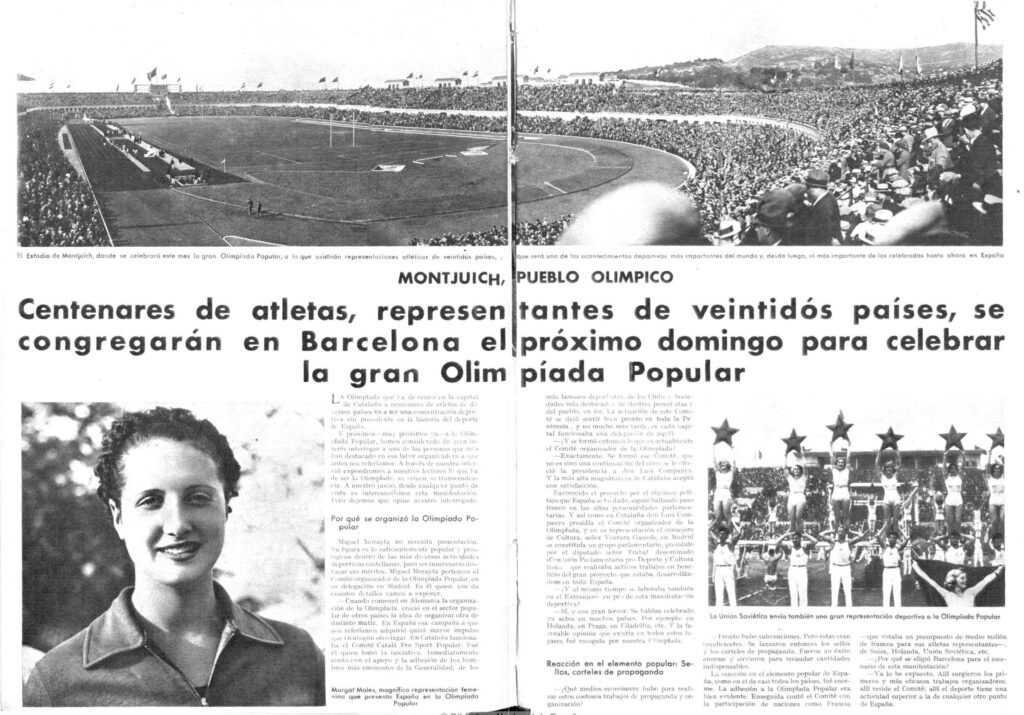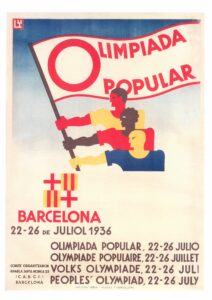Chick Chakin’s Last Chance
Like many participants in the 1936 Popular Olympics in Barcelona, Alfred Chakin was a talented athlete. He was also a committed antifascist.
Al Chakin was 32 when he visited Barcelona for the first time, but between his bad knee and the incessant energy of his youthful charges, the wrestling coach already felt old. The knee which had ended his Olympic dreams probably didn’t enjoy the long voyage on ships, trains, and buses that he took from New York to Barcelona. Yet despite having all but given up on his hopes of Olympic glory, he was now in Barcelona to compete in the Olympic games.
Like many participants in the 1936 Popular Olympics, Abraham Alfred Chakin, known to his friends as Chick, was a talented athlete. He’d wrestled his way from a working-class immigrant home to Cornell and very nearly onto the 1924 Olympic squad. Like those of many Lincolns, Chakin’s parents had fled anti-Semitism in Europe and come to settle in New York in search of a better life. In Chakin’s case, his family had left Russia when he was less than a year old. Thirty-one years later, he returned across the Atlantic to fight a new kind of bigotry that was emerging in Europe. His intention was to show the world the strength and diversity of anti-fascism though participation in a huge sporting spectacle. But after arriving in Barcelona in the third week of July 1936, he quickly found that if he wanted to turn back fascism he would need to fight outside of the mat.
Officially, Chakin was the coach of the US team for the Popular Olympiad, but “big brother” might be a better term. By 1936 he’d experienced victory, defeat, injury, and just about everything else that sport can throw at an athlete. He’d started wrestling in school and by his final year at Cornell, Chakin’s team was undefeated and won the Eastern Intercollegiate Wrestling Association title. Chakin took the individual title in the 135lb weight class. He took summer school classes to finish up his degree.
He’d narrowly missed out on selection in the 1924 games, beaten out by two wrestlers who went on to win gold and silver. After graduating on September 25, 1926, with a BA, Chakin won the 1927 Amateur Athletic Union Niagara District Wrestling championships, an Olympic qualifying event. Despite this, he didn’t make the team in 1928 and had probably all but given up on seeing the world.
Instead, he pursued a master’s degree at City College New York and taught physical education. It was there that he met Jennie Berman. Although she was just four months older than Al, Jennie, a social worker and a Communist firebrand, was a much more experienced activist. She graduated from Syracuse University in 1925 and headed directly for the city to join the Communist Party and begin organizing. The year before they married, she had made headlines when she led New York’s Jewish community social service agencies in a walkout for union recognition. It was through her that Al developed his politics and deep-rooted dislike of fascism and inequality.
 His team for the Barcelona games had been cobbled together on short notice and little money. Most of them were avid participants in the workers’ sport movement on the east coast, and keen to test themselves against fellow workers from around the globe while also showing their solidarity in the face of a growing fascist threat. Much to the delight of the organizers in Barcelona, the team contained both Black and white athletes—including the 19-year-old Charley Burley, who at one time seen as the best pound for pound boxer in the world.
His team for the Barcelona games had been cobbled together on short notice and little money. Most of them were avid participants in the workers’ sport movement on the east coast, and keen to test themselves against fellow workers from around the globe while also showing their solidarity in the face of a growing fascist threat. Much to the delight of the organizers in Barcelona, the team contained both Black and white athletes—including the 19-year-old Charley Burley, who at one time seen as the best pound for pound boxer in the world.
Burley was something of a celebrity, even to Chakin, who was thirteen years his senior. As a mixed-race boy in the rapidly dying coal towns of Western Pennsylvania, Charley hadn’t had an easy upbringing. He and Al seemed to get along, and on the way to Barcelona they’d spar on the deck of the Transylvania. But even before they landed in Europe, the team would have their commitment to equality tested.
Walking into dinner after four days aboard, Chakin’s team found their table moved for the third time. Apparently, some of the more “high-class” passengers had objected to taking their dinner in view of the team’s Black members. The team put their collective foot down and refused to move. Despite his diminutive stature, Al Chakin had the air of a man who was confident in starting fights because he was confident in finishing them. The table stayed put, and the team ate together with other passengers.
The team slowly wound its way through Europe, landing first in Dublin then in Glasgow. From there, they took a train to London for a round of press interviews before setting off south to catch a ferry to France. Chakin got his own sub headline in the Daily Worker, where he was billed as a “college champ” with a “grand smile and grip.” “Alfred knows his stuff, believe me” the Daily Worker’s sports editor assured his readers beneath an image of Chakin with his unmistakably wide grin and flat nose. On the train, they played Pinochle, grew accustomed to being slightly famous as the story of the games spread through unions and the left-wing press, and met an Englishman named Mike Samuelson who invited them to his home on their return trip and brought them drinks.
However, their return, and much of the rest of their trip, would not go quite as smoothly as their voyage through the UK. On arrival in Catalonia on July 16, the team drank up the revolutionary atmosphere of July 1936. With the Hotel Olympic already full, they were assigned rooms in the Hotel Europa, a Catalan Modernist building just feet from the bustling Boquería market and yards from the Rambla. Finding themselves exhausted from nearly two weeks of travel, the team of dedicated athletes did the sensible thing and headed out for a night on the town. Over the next few days, they trained in the stadium and drank in the bars.
But on the day the team had been hoping to show the sporting prowess of anti-fascism, they ended up getting a different show altogether. On July 19, instead of leaving for the stadium, they ran to their balconies as gunshots rang out around the city. The hotel doors were locked, but soon some of the athletes were able to take advantage of a lull in the fighting to get some food and help the Catalans build up their barricades.
 By the time they got out, the air was thick with smoke and the stench of cordite. Despite the chaos, the athletes all organized a march from their hotel to the stadium, where they worked out and assumed that they would still be competing. After all, the coup had clearly been snuffed out by the decisive action of the Catalan workers. Then more shots rang out, and they were forced to flee as the soldiers in the Montjuïc Castle just 800 meters away fired into the stadium.
By the time they got out, the air was thick with smoke and the stench of cordite. Despite the chaos, the athletes all organized a march from their hotel to the stadium, where they worked out and assumed that they would still be competing. After all, the coup had clearly been snuffed out by the decisive action of the Catalan workers. Then more shots rang out, and they were forced to flee as the soldiers in the Montjuïc Castle just 800 meters away fired into the stadium.
With the games postponed, the US Consulate told the team in no uncertain terms that if they did not leave, they would no longer be receiving the assistance of the consul. Besides, there could be no games without the locals and most of them had already set off for Zaragoza. Feeling dejected, they boarded the Ciudad de Ibiza along with the Belgian, Swiss, and other delegations. They traveled to Paris and competed in an athletics meet there before heading back to the USA to watch from afar as western governments abandoned their Spanish and Catalan counterparts and fascists embraced the rebellion they’d seen defeated by the Catalan workers.
At a fundraising rally back in New York, Chakin said that “if they weren’t class conscious before” they arrived in Barcelona, the athletes “certainly were after they saw the workers.” Chakin’s own consciousness was also changed by what he saw. Despite his age and dodgy knee, he couldn’t stand watching from the sidelines. While this is hardly an admirable quality in a coach, it’s what led him to volunteer to fight in Spain. On July 7, 1937, he set sail for what would be his final trip across the Atlantic aboard the Queen Mary. He arrived in Setcases on July 18, 1937, exactly a year after he had gone to sleep in the Hotel Europa and awoken to the sound of gunfire. This time, there was no hotel door to keep him safe and Chakin quickly found himself, once again, fighting.
He served as quartermaster of the Mackenzie-Papineau Battalion, better known as the Mac-Paps. Although named for Canadians, the Battalion was mostly comprised of US volunteers. His record in service there is sparse, he must have been present for the Mac-Paps’ finest hour at Teruel, but he did not survive the chaotic retreats around Caspe. At some point, as the Mac-Paps trekked from Azuara to Lecera hounded by fast moving Whippet tanks, Chakin went missing and was never heard from again.
Berman had joined him in Spain at first, helping to create the first Art Therapy program for children traumatized by war. But she returned to the US without Chick. She’d agonized before he left, wondering if telling the doctor about his bad knee was the right thing to do. It was a decision she lived with for the rest of her life, as she recounts in the documentary film The Good Fight. Chakin, along with a dozen other CCNY alumni and faculty, is memorialized in a plaque at the college today. Although he might have felt old by surrounded by students, then athletes, then soldiers, Chakin never lived to see his 35th birthday. He never quite made it to the opening ceremony of an Olympic games either, despite trying out for three. He’d spent his life fighting for everything he wanted; he died fighting for something he believed in.
James Stout’s PhD in History focused on the construction of Catalan anti-fascist identity through sport in the Second Republic. He now works as a journalist covering conflict and displaced people.













